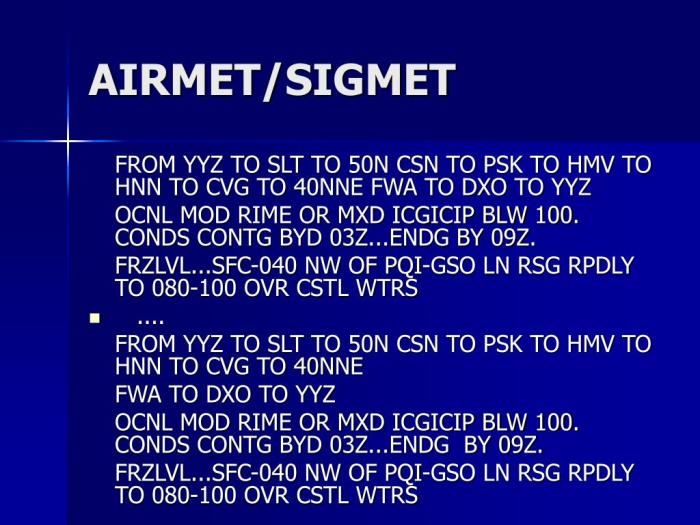In the realm of aviation, accurate and timely weather information is paramount for ensuring safety and efficiency. Among the critical tools used by pilots and aviation professionals are AIRMETs (AIRspace METeorological Advisories) and SIGMETs (Significant METeorological Advisories). Understanding the difference between AIRMET and SIGMET is essential for proper interpretation and effective decision-making in the cockpit.
AIRMETs and SIGMETs are weather advisories issued by meteorological authorities to provide pilots with information about potentially hazardous weather conditions that could affect their flight operations. While both types of advisories serve a vital role in enhancing safety, they differ in their target audience, scope, and issuance criteria.
Overview of AIRMET and SIGMET
AIRMET (AIRcraft METeorological Information) and SIGMET (Significant METeorological Information) are two types of weather advisories issued by the National Weather Service (NWS) to provide pilots with information about hazardous weather conditions that could affect the safety of their flights.
AIRMETs are issued for weather conditions that are less severe than those covered by SIGMETs, but which could still pose a hazard to aircraft. These conditions include moderate turbulence, moderate icing, moderate mountain obscuration, and sustained winds of 30 knots or more.
SIGMETs are issued for weather conditions that are considered to be significant hazards to aircraft. These conditions include severe turbulence, severe icing, severe mountain obscuration, and sustained winds of 50 knots or more.
Purpose and Target Audience
AIRMETs and SIGMETs are both intended to provide pilots with timely information about hazardous weather conditions so that they can take appropriate action to avoid or mitigate the risks associated with these conditions.
AIRMETs are primarily intended for general aviation pilots, while SIGMETs are intended for all pilots, regardless of their experience level.
Similarities and Differences
AIRMETs and SIGMETs are both weather advisories that are issued by the NWS to provide pilots with information about hazardous weather conditions.
However, there are some key differences between the two types of advisories. AIRMETs are issued for less severe weather conditions than SIGMETs, and they are intended for general aviation pilots.
SIGMETs are issued for more severe weather conditions, and they are intended for all pilots, regardless of their experience level.
Content and Issuance of AIRMET and SIGMET

AIRMETs and SIGMETs provide timely information on potentially hazardous weather conditions that may affect aviation operations. The types of weather phenomena covered by these advisories include:
- AIRMETs:
- Moderate icing
- Moderate turbulence
- Sustained winds of 30 knots or more
- Visibility less than 3 miles
- Ceiling less than 1,000 feet
- SIGMETs:
- Severe icing
- Severe turbulence
- Widespread thunderstorms
- Volcanic ash
- Tornadoes
The criteria and thresholds for issuing AIRMETs and SIGMETs vary depending on the specific weather phenomenon. For example, an AIRMET for moderate icing is issued when icing is expected to be encountered at altitudes between 0 and 10,000 feet above ground level (AGL) and with an intensity of moderate or greater.
AIRMETs and SIGMETs are issued by the National Weather Service (NWS) and disseminated through a variety of channels, including:
- Aviation Weather Center (AWC)
- Flight Service Stations (FSS)
- Automated Terminal Information Service (ATIS)
- Weather Broadcast (WB)
Dissemination and Use of AIRMET and SIGMET

AIRMETs and SIGMETs are disseminated to pilots and aviation professionals through various methods, including:
- Aviation Weather Center (AWC) website
- National Weather Service (NWS) website
- Automated Terminal Information Service (ATIS)
- Flight Service Stations (FSS)
- Aircraft Cockpit Weather Information System (ACWIS)
Pilots use AIRMETs and SIGMETs to plan and execute safe flights by providing them with timely information about hazardous weather conditions. They use this information to:
- Determine the best route of flight
- Avoid hazardous weather areas
- Plan for alternate landing sites
- Make informed decisions about whether to delay or cancel a flight
Examples of How AIRMETs and SIGMETs Have Been Used to Prevent Accidents or Incidents
- In 2017, a SIGMET was issued for a severe thunderstorm over the Dallas-Fort Worth area. Several flights were diverted or delayed as a result, and no accidents or incidents were reported.
- In 2018, an AIRMET was issued for icing conditions in the Midwest. Several flights were delayed or canceled as a result, and no accidents or incidents were reported.
Comparison of AIRMET and SIGMET
AIRMETs and SIGMETs are two types of aviation weather forecasts issued by the National Weather Service (NWS). Both provide pilots with information about hazardous weather conditions that could affect their flight, but there are some key differences between the two.
The following table compares the key features of AIRMETs and SIGMETs:
| Feature | AIRMET | SIGMET |
|---|---|---|
| Type of weather phenomena covered | Moderate icing, moderate turbulence, sustained winds of 30 knots or more at the surface, widespread areas of ceilings less than 1,000 feet and/or visibility less than 3 miles | Severe icing, severe turbulence, dust storms, sandstorms, volcanic ash, and thunderstorms |
| Issuance criteria | When the NWS expects the weather phenomena to pose a threat to aviation | When the NWS expects the weather phenomena to pose a serious threat to aviation |
| Dissemination methods | Issued via the Automated Weather Information System (AWIS), the Aviation Weather Center (AWC), and the NWS website | Issued via the AWIS, the AWC, and the NWS website, and are also broadcast over the Aeronautical Information Service (AIS) |
| Target audience | Pilots of small aircraft | Pilots of all aircraft |
Case Studies and Examples: Difference Between Airmet And Sigmet

AIRMETs and SIGMETs play a crucial role in enhancing aviation safety and efficiency. Numerous case studies and examples demonstrate their impact on aviation operations.
In 2019, an AIRMET was issued for severe turbulence over the central United States. This prompted several airlines to reroute their flights, avoiding the affected area. The timely issuance of the AIRMET prevented potential damage to aircraft and injuries to passengers.
Impact on Aviation Operations, Difference between airmet and sigmet
AIRMETs and SIGMETs directly influence aviation operations by:
- Providing pilots with real-time information about hazardous weather conditions, allowing them to make informed decisions about flight routes and altitudes.
- Facilitating coordination between air traffic controllers and pilots, ensuring the safe and efficient flow of air traffic.
li>Reducing the risk of accidents and incidents by alerting pilots to potential hazards and providing guidance on how to mitigate them.
Popular Questions
What is the primary difference between AIRMET and SIGMET?
AIRMETs focus on weather conditions that could affect general aviation operations, while SIGMETs are issued for more severe weather phenomena that pose a significant hazard to all aircraft.
Who is the target audience for AIRMETs?
AIRMETs are primarily intended for general aviation pilots operating below 18,000 feet.
What are some examples of weather phenomena covered by SIGMETs?
SIGMETs are issued for severe thunderstorms, icing, turbulence, volcanic ash, and other hazardous weather conditions that could significantly impact aircraft operations.